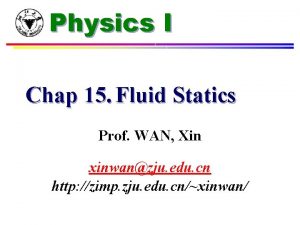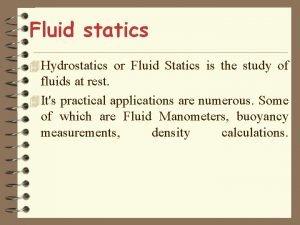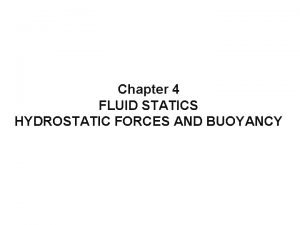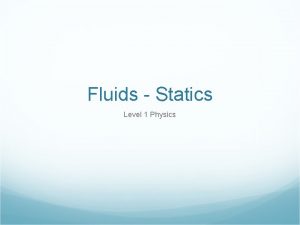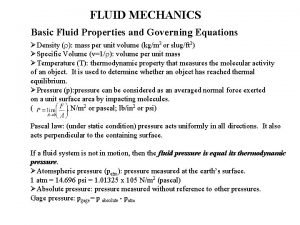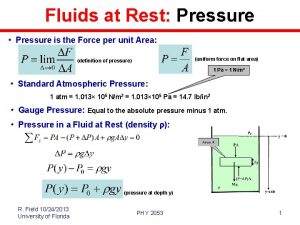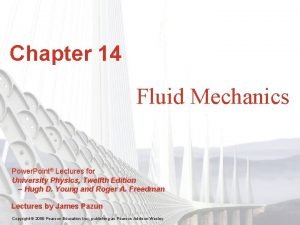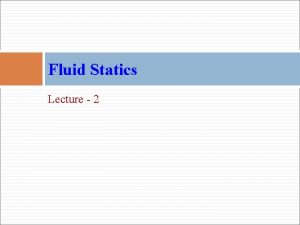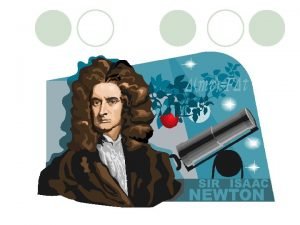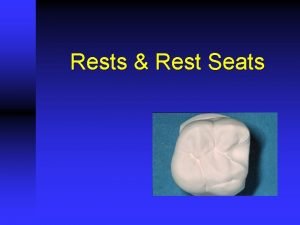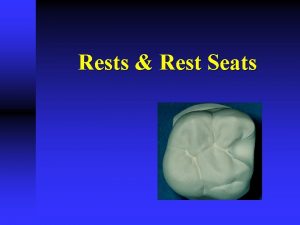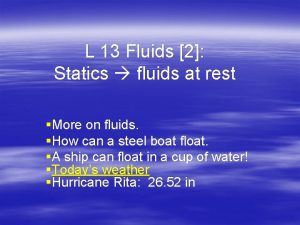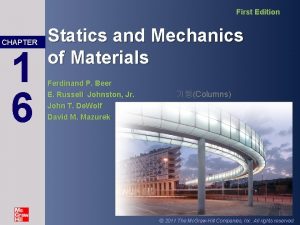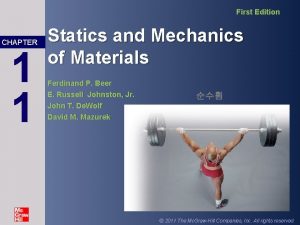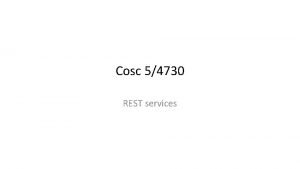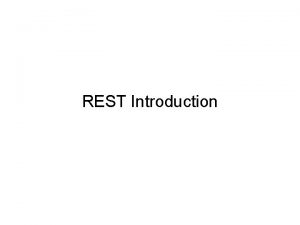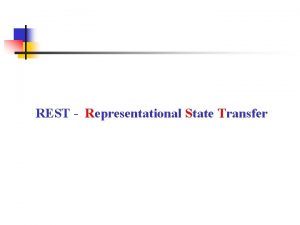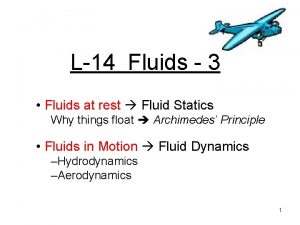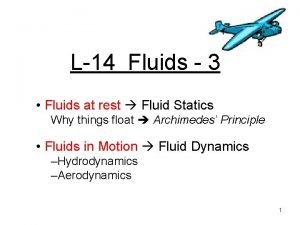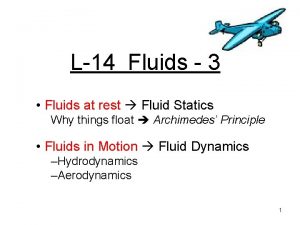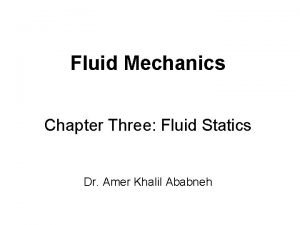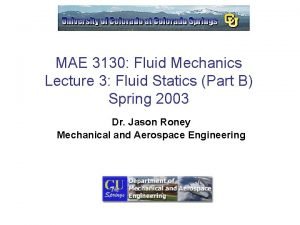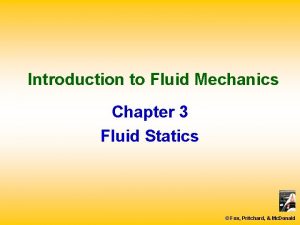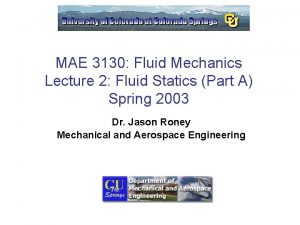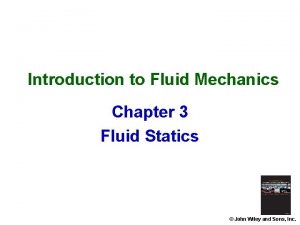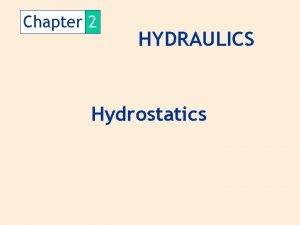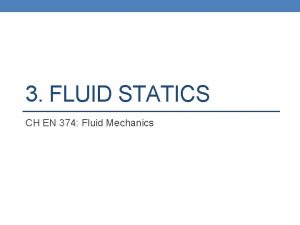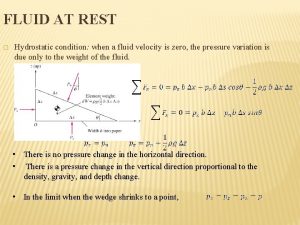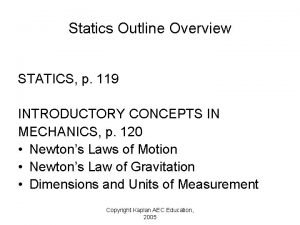Ch 2 Fluid Statics Fluid either at rest
























- Slides: 24

Ch 2 Fluid Statics • Fluid either at rest or moving in a manner that there is no relative motion between adjacent particles. • No shearing stress in the fluid • Only pressure (force that develop on the surfaces of the particles)

2. 1 Pressure at a point N/m 2 (Force/Area) Y: Z:

What happen at a pt. ? is arbitrarily chosen Pressure at a pt. in a fluid at rest, or in motion, is independent of direction as long as there are no shearing stresses present. (Pascal’s law)

2. 2 Basic equation for Pressure Field How does the pressure in a fluid which there are no shearing stresses vary from pt. to pt. ? Surface & body forces acting on small fluid element pressure weight

Surface forces: Similarly, in z and x directions:

Newton’s second law General equation of motion for a fluid in which there are no shearing stresses. 2. 3 Pressure variation in a fluid at rest

2. 3. 1 Incompressible Hydrostatic Distribution *see Fig. 2. 2 pressure head Ex: Pressure in a homogeneous, incompressible fluid at rest: ~ reference level, indep. of size or shape of the container.

The required equality of pressures at equal elevations Throughout a system. Transmission of fluid pressure 2. 3. 2 Compressible Fluid Assume perfect gas:

2. 4 Standard Atmosphere Troposphere:

2. 5 Measurement of Pressure See Fig. 2. 7 Absolute & Gage pressure (Mercury barometer) Example 2. 3 2. 6 Manometry 1. Piezometer Tube: 2. U-Tube Manometer: 3. Inclined-tube manometer see examples *explain Fig. 2. 11 Differential U-tube manometer Example 2. 5

Ex. 2. 5 2. 6. 3 Fig. 2. 12 Inclined tube manometer Small difference in gas pressure If pipes A & B contain a gas

2. 7 Mechanical and Electronic Pressure Measuring Device . Bourdon pressure gage (elastic structure) Bourdon Tube curved tube deformation straight dial . A zero reading on the gage indicates that the measured pressure . Aneroid barometer-measure atmospheric pressure (absolute pressure). Pressure transducer-pressure V. S. time Bourdon tube is connected to a linear variable differential transformer(LVDT), Fig. 2. 14 coil; voltage

This voltage is linear function of the pressure, and could be recorded on an oscillograph, or digitized for storage or processing on computer. Disadvantage-elastic sensing element meas. pressure are static or only changing slowly(quasistatic). relatively mass of Bourdon tube <diaphragm> 1 Hz *strain-gage pressure transducer * Fig. 2. 15 (arterial blood pressure) piezo-electric crystal. (Refs. 3, 4, 5 )

2. 8 Hydrostatic Force on a Plane Surface Fig. 2. 16 Pressure and resultants hydrostatic force developed on the bottom of an open tank. Storage tanks, ships . For fluid at rest we know that the force must be perpendicular to the surface, since there are no shearing stress present.

. Pressure varies linearly with depth if incompressible for open tank, Fig. 2. 16 The resultant force acts through the centroid of the area * Exercise 1. 66 torque shearing stress Assume velocity distribution in the gap is linear

first moment of the area Indep. Of The moment of the resultant force must equal the moment of the Distributed pressure force

Note: Ixy-the product of inertia wrt the x& y area. Ixyc-the product of inertia wrt to an orthogonal coord. system passing through the centroid of the area. If the submerged area is symmetrical wrt an axes passing through the centroid and parallel to either the x or y axes, the resultant force must lie along the line x=xc, since Ixyc= 0. Center of pressure (Resultant force acts points)

Example 2. 6 求a. b. a. b.

2. 9 Pressure Prism the pressure varies linearly with depth. See Fig. 2. 19 No matter what the shape of the pressure prism is, the resultant force is still equal in magnitude to the volume of the pressure Prism, and it passes through the centroid of the volume. First, draw the pressure prism out.

Example 2. 8

2. 10 Hydrostatic Force on a Curved Surface. Eqs. Developed before only apply to the plane surfaces magnitude and location of. Integration: tedious process/ no simple, general formulas can be developed. . Fig. 2. 23 For equilibrium, collinear. through pt

Example 2. 9 排水管受力情形 See Fig. 2. 18 at C. G (Centroid; center of pressure, CP; center of gravity)

Similarly

2. 11 Buoyancy, Flotation, and Stability 2. 11. 1 阿基米德原理 請看圖 2. 24, 來分析其受力情形 任意形狀的物體之體積 2. 11. 2 Stability stable equilibrium stable Light Heavy Stable neutral Heavy Light unstable Explain Fig. 2. 25; 26; 27; 28 unstable L H H L
 P1-p2
P1-p2 Fluid statics deals with
Fluid statics deals with Archimedes of syracuse
Archimedes of syracuse Fluid statics formulas
Fluid statics formulas Fluid statics deals with
Fluid statics deals with Fluid statics questions
Fluid statics questions Fluid statics
Fluid statics Examples of fluid statics
Examples of fluid statics Fluid kinematics - ppt
Fluid kinematics - ppt Define fluid statics
Define fluid statics Newton's second lawlaw
Newton's second lawlaw Direct retainer in rpd
Direct retainer in rpd Hamlet in purgatory
Hamlet in purgatory Occlusal rest
Occlusal rest Cingulum rest preparation
Cingulum rest preparation Fluids at rest
Fluids at rest Positive shifting dullness
Positive shifting dullness Interstitial fluid vs extracellular fluid
Interstitial fluid vs extracellular fluid Fluid sf
Fluid sf Define fluid kinematics
Define fluid kinematics Transcellular fluid compartment
Transcellular fluid compartment Movement of body fluids
Movement of body fluids How does water go through your body
How does water go through your body Statics
Statics Statics
Statics


